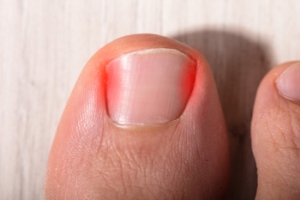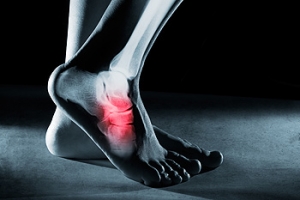Connect With Us

Bunions
A bunion is an enlargement of the base joint of the toe that connects to the foot, often formed from a bony growth or a patch of swollen tissues. It is caused by the inward shifting of the bones in the big toe, toward the other toes of the foot. This shift can cause a serious amount of pain and discomfort. The area around the big toe can become inflamed, red, and painful.
Bunions are most commonly formed in people who are already genetically predisposed to them or other kinds of bone displacements. Existing bunions can be worsened by wearing improperly fitting shoes. Trying to cram your feet into high heels or running or walking in a way that causes too much stress on the feet can exacerbate bunion development. High heels not only push the big toe inward, but shift one's body weight and center of gravity towards the edge of the feet and toes, expediting bone displacement.
A podiatrist knowledgeable in foot structure and biomechanics will be able to quickly diagnose bunions. Bunions must be distinguished from gout or arthritic conditions, so blood tests may be necessary. The podiatrist may order a radiological exam to provide an image of the bone structure. If the x-ray demonstrates an enlargement of the joint near the base of the toe and a shifting toward the smaller toes, this is indicative of a bunion.
Wearing wider shoes can reduce pressure on the bunion and minimize pain, and high heeled shoes should be eliminated for a period of time. This may be enough to eliminate the pain associated with bunions; however, if pain persists, anti-inflammatory drugs may be prescribed. Severe pain may require an injection of steroids near the bunion. Orthotics for shoes may be prescribed which, by altering the pressure on the foot, can be helpful in reducing pain. These do not correct the problem; but by eliminating the pain, they can provide relief.
For cases that do not respond to these methods of treatment, surgery can be done to reposition the toe. A surgeon may do this by taking out a section of bone or by rearranging the ligaments and tendons in the toe to help keep it properly aligned. It may be necessary even after surgery to wear more comfortable shoes that avoid placing pressure on the toe, as the big toe may move back to its former orientation toward the smaller toes.
Possible Causes of Ingrown Toenails
 People who develop ingrown toenails are often aware of the pain and discomfort they can cause. Wearing shoes that do not fit correctly may cause the corner of the toenail to grow into the skin, and the affected area typically appears to be red and swollen. Additionally, poorly shaped toenails may come from genetic factors, and existing fungal infections may lead to abnormal toenails. Patients may find mild relief when the affected toe is soaked in warm water, and this may help to promote healing. If you are afflicted with an ingrown toenail, it is strongly suggested that you speak with a podiatrist as quickly as possible who can effectively treat this condition.
People who develop ingrown toenails are often aware of the pain and discomfort they can cause. Wearing shoes that do not fit correctly may cause the corner of the toenail to grow into the skin, and the affected area typically appears to be red and swollen. Additionally, poorly shaped toenails may come from genetic factors, and existing fungal infections may lead to abnormal toenails. Patients may find mild relief when the affected toe is soaked in warm water, and this may help to promote healing. If you are afflicted with an ingrown toenail, it is strongly suggested that you speak with a podiatrist as quickly as possible who can effectively treat this condition.
Ingrown toenails can become painful if they are not treated properly. For more information about ingrown toenails, contact Dr. Richard Silverstein of Union Foot Care. Our doctor can provide the care you need to keep you pain-free and on your feet.
Ingrown Toenails
Ingrown toenails occur when a toenail grows sideways into the bed of the nail, causing pain, swelling, and possibly infection.
Causes
- Bacterial infections
- Improper nail cutting such as cutting it too short or not straight across
- Trauma to the toe, such as stubbing, which causes the nail to grow back irregularly
- Ill-fitting shoes that bunch the toes too close together
- Genetic predisposition
Prevention
Because ingrown toenails are not something found outside of shoe-wearing cultures, going barefoot as often as possible will decrease the likeliness of developing ingrown toenails. Wearing proper fitting shoes and using proper cutting techniques will also help decrease your risk of developing ingrown toenails.
Treatment
Ingrown toenails are a very treatable foot condition. In minor cases, soaking the affected area in salt or antibacterial soaps will not only help with the ingrown nail itself, but also help prevent any infections from occurring. In more severe cases, surgery is an option. In either case, speaking to your podiatrist about this condition will help you get a better understanding of specific treatment options that are right for you.
If you have any questions please feel free to contact our office located in Havre de Grace, MD . We offer the newest diagnostic and treatment technologies for all your foot and ankle needs.
Ingrown Toenails
An ingrown toenail is a nail that has curved downward and grown into the skin. This typically occurs at either the nail borders or the sides of the nail. As a result, pain, redness, swelling, and warmth may occur in the toe. If a break in the skin forms due to the ingrown nail, bacteria may enter and cause an infection in the area; this is typically characterized by a foul odor and drainage.
Ingrown toenails have multiple reasons for developing. In many instances, the condition is a result of genetics and is inherited. The most common cause, however, is improper trimming; cutting the toenails too short forces the skin beside the nail to fold over. An ingrown toenail can also develop due to trauma, such as stubbing the toe, having an object fall on the toe, or participating in activities that involve repeated kicking or running. Wearing shoes that are too tight or too short can also cause ingrown toenails.
Treatment for an ingrown toenail varies between patients and the severity of the condition. In most cases, it is best to see your podiatrist for thorough and proper treatment. After examining your toe, your podiatrist may prescribe oral antibiotics to clear the infection if one is present. Surgical removal of either a portion of the nail or the entire nail may also be considered. In some cases, complete removal or destruction of the nail root may be required. Most patients who undergo nail surgery experience minimal pain afterward and can return to normal activity the following day.
Ingrown toenails can be prevented with proper nail trimming and by avoiding improper-fitting shoes. When cutting the toenails, be sure that you are cutting in a straight line and avoid cutting them too short. Shoes should not be too short or tight in the toe box.
Are You Suffering From Ingrown Toenails?
Morning Foot Pain
 Foot pain in the morning can indicate the existence of specific conditions that can include plantar fasciitis, plantar warts, or rheumatoid arthritis. Plantar fasciitis may be prevented by wearing shoes that fit correctly, in addition to replacing them approximately every five hundred miles. Plantar warts develop on the sole of the foot, and are caused by a virus. This condition can cause severe pain and discomfort, and relief may be found by implementing immediate treatment. Stiff feet in the morning may be a sign of rheumatoid arthritis, and the pain may continue throughout the day. If you are experiencing any type of foot pain, it is strongly recommended that you are under the care of a podiatrist who can effectively treat and manage foot ailments.
Foot pain in the morning can indicate the existence of specific conditions that can include plantar fasciitis, plantar warts, or rheumatoid arthritis. Plantar fasciitis may be prevented by wearing shoes that fit correctly, in addition to replacing them approximately every five hundred miles. Plantar warts develop on the sole of the foot, and are caused by a virus. This condition can cause severe pain and discomfort, and relief may be found by implementing immediate treatment. Stiff feet in the morning may be a sign of rheumatoid arthritis, and the pain may continue throughout the day. If you are experiencing any type of foot pain, it is strongly recommended that you are under the care of a podiatrist who can effectively treat and manage foot ailments.
Foot Pain
Foot pain can be extremely painful and debilitating. If you have a foot pain, consult with Dr. Richard Silverstein from Union Foot Care. Our doctor will assess your condition and provide you with quality foot and ankle treatment.
Causes
Foot pain is a very broad condition that could be caused by one or more ailments. The most common include:
- Bunions
- Hammertoes
- Plantar Fasciitis
- Bone Spurs
- Corns
- Tarsal Tunnel Syndrome
- Ingrown Toenails
- Arthritis (such as Gout, Rheumatoid, and Osteoarthritis)
- Flat Feet
- Injury (from stress fractures, broken toe, foot, ankle, Achilles tendon ruptures, and sprains)
- And more
Diagnosis
To figure out the cause of foot pain, podiatrists utilize several different methods. This can range from simple visual inspections and sensation tests to X-rays and MRI scans. Prior medical history, family medical history, and any recent physical traumatic events will all be taken into consideration for a proper diagnosis.
Treatment
Treatment depends upon the cause of the foot pain. Whether it is resting, staying off the foot, or having surgery; podiatrists have a number of treatment options available for foot pain.
If you have any questions, please feel free to contact our office located in Havre de Grace, MD . We offer the newest diagnostic and treatment technologies for all your foot care needs.
Foot Pain
Our feet are arguably the most important parts of our bodies because they are responsible for getting us from place to place. However, we often don’t think about our feet until they begin to hurt. If you have pain in your feet, you need to first determine where on the foot you are experiencing it to get to the root of the problem. The most common areas to feel pain on the foot are the heel and the ankle.
Heel pain is most commonly attributed to a condition called plantar fasciitis. Plantar fasciitis occurs when the plantar fascia, which is the band of tough tissue connecting the heel bone to the toes becomes inflamed. Plantar fasciitis pain is usually worse in the morning, and it tends to go away throughout the day. If you have plantar fasciitis, you should rest your foot and do heel and foot muscles stretches. Wearing shoes with proper arch support and a cushioned sole has also been proven to be beneficial.
Some common symptoms of foot pain are redness, swelling, and stiffness. Foot pain can be dull or sharp depending on its underlying cause. Toe pain can also occur, and it is usually caused by gout, bunions, hammertoes, ingrown toenails, sprains, fractures, and corns.
If you have severe pain in your feet, you should immediately seek assistance from your podiatrist for treatment. Depending on the cause of your pain, your podiatrist may give you a variety of treatment options.
Are You Suffering From Tarsal Tunnel Syndrome?
 The tarsal tunnel is a narrow tunnel in the ankle, next to the ankle bone, that serves as a pathway for nerves, veins, arteries and tendons. Tarsal tunnel syndrome occurs when the tibial nerve in this tunnel gets squeezed or pressed. Common causes of tarsal tunnel syndrome include osteoarthritis, rheumatoid arthritis, diabetes, overpronation (rolling) of the foot, or a cyst or ganglion that can form near the tunnel. Symptoms of tarsal tunnel syndrome include a burning pain that radiates to the arch of the foot, numbness in the sole of the foot and worsening of symptoms after running or standing for a long time. If you believe that you might be suffering from tarsal tunnel syndrome, it is important to visit a podiatrist for a proper diagnosis and treatment. Treatment options that may be considered include cold therapy, medication, injections, specific exercises, corticosteroid injections or surgery.
The tarsal tunnel is a narrow tunnel in the ankle, next to the ankle bone, that serves as a pathway for nerves, veins, arteries and tendons. Tarsal tunnel syndrome occurs when the tibial nerve in this tunnel gets squeezed or pressed. Common causes of tarsal tunnel syndrome include osteoarthritis, rheumatoid arthritis, diabetes, overpronation (rolling) of the foot, or a cyst or ganglion that can form near the tunnel. Symptoms of tarsal tunnel syndrome include a burning pain that radiates to the arch of the foot, numbness in the sole of the foot and worsening of symptoms after running or standing for a long time. If you believe that you might be suffering from tarsal tunnel syndrome, it is important to visit a podiatrist for a proper diagnosis and treatment. Treatment options that may be considered include cold therapy, medication, injections, specific exercises, corticosteroid injections or surgery.
Tarsal tunnel syndrome can be very uncomfortable to live with. If you are experiencing tarsal tunnel syndrome, contact Dr. Richard Silverstein of Union Foot Care. Our doctor can provide the care you need to keep you pain-free and on your feet.
Tarsal Tunnel Syndrome
Tarsal tunnel syndrome, which can also be called tibial nerve dysfunction, is an uncommon condition of misfiring peripheral nerves in the foot. The tibial nerve is the peripheral nerve in the leg responsible for sensation and movement of the foot and calf muscles. In tarsal tunnel syndrome, the tibial nerve is damaged, causing problems with movement and feeling in the foot of the affected leg.
Common Cause of Tarsal Tunnel Syndrome
- Involves pressure or an injury, direct pressure on the tibial nerve for an extended period of time, sometimes caused by other body structures close by or near the knee.
- Diseases that damage nerves, including diabetes, may cause tarsal tunnel syndrome.
- At times, tarsal tunnel syndrome can appear without an obvious cause in some cases.
The Effects of Tarsal Tunnel Syndrome
- Different sensations, an afflicted person may experience pain, tingling, burning or other unusual sensations in the foot of the affected leg.
- The foot muscles, toes and ankle become weaker, and curling your toes or flexing your foot can become difficult.
- If condition worsens, infections and ulcers may develop on the foot that is experiencing the syndrome.
A physical exam of the leg can help identify the presence of tarsal tunnel syndrome. Medical tests, such as a nerve biopsy, are also used to diagnose the condition. Patients may receive physical therapy and prescriptive medication. In extreme cases, some may require surgery.
If you have any questions please feel free to contact our office located in Havre de Grace, MD . We offer the newest diagnostic and treatment technologies for all your foot and ankle needs.
Tarsal Tunnel Syndrome
Tarsal tunnel syndrome is a condition in which there is a compression of the posterior tibial nerve. The posterior tibial nerve runs along the inside of the ankle into the foot. Tarsal tunnel syndrome is named for the tarsal tunnel, which is a thin space along the inside of the ankle beside the ankle bones. This space contains various nerves, arteries, and tendons, and includes the posterior tibial nerve. The tibial nerve is the peripheral nerve in the leg responsible for sensation and movement of the foot and calf muscles. In tarsal tunnel syndrome the tibial nerve is compressed, causing tingling or burning, numbness, and pain.
Common causes of tarsal tunnel syndrome involve pressure or an injury. Injuries that produce inflammation and swelling in or around the tunnel may place pressure on the posterior tibial nerve. Direct pressure on the tibial nerve for an extended period of time, sometimes caused by other body structures close by or trauma to the tibial nerve, can result in tarsal tunnel syndrome. Diseases that damage nerves, such as diabetes or arthritis, may cause tarsal tunnel syndrome. Those with flat feet are at risk for developing the condition, as the extra pressure and strain placed on the foot may compress the posterior tibial nerve.
Feeling different sensations in the foot at different times is a common symptom of tarsal tunnel syndrome. An afflicted person may experience pain, tingling, burning or other unusual sensations in the foot of the affected leg. Symptoms are primarily felt on bottom of the foot and/or the inside of the ankle. Symptoms can appear suddenly and may occur due to overuse of the foot.
To diagnose tarsal tunnel syndrome, your podiatrist may examine the foot and tap the posterior tibial nerve to see if symptoms surface. He or she may also order an MRI to determine if a mass is present.
Treating tarsal tunnel syndrome will depend on the decision of your podiatrist. Multiple options are available, however, and can include rest, ice, immobilization, oral medications such as anti-inflammatory drugs (NSAIDS), physical therapy, injection therapy, orthotics, supportive shoes, braces, and surgery.
Are Bunions Affecting Your Everyday Life?
Signs of Plantar Fasciitis
 Plantar fasciitis is the result of the plantar fascia, the fibrous band of tissue on the bottom of the foot that connects the toes to the heel, becoming inflamed. A sharp pain inside the heel and at the back of the arch is a key signal of plantar fasciitis. Most of the pain that is experienced from plantar fasciitis gradually worsens over time, and it is usually the worst after prolonged periods of rest. For example, after waking up in the morning the pain is at its worst because the plantar fascia shortens when the foot is at rest. Those who have plantar fasciitis may also experience tenderness in the heel, a tingling or burning sensation in the foot, pain while flexing the foot, and limping. If you are experiencing any of the symptoms that indicate plantar fasciitis, consulting with a podiatrist for a proper diagnosis and treatment plan is highly recommended.
Plantar fasciitis is the result of the plantar fascia, the fibrous band of tissue on the bottom of the foot that connects the toes to the heel, becoming inflamed. A sharp pain inside the heel and at the back of the arch is a key signal of plantar fasciitis. Most of the pain that is experienced from plantar fasciitis gradually worsens over time, and it is usually the worst after prolonged periods of rest. For example, after waking up in the morning the pain is at its worst because the plantar fascia shortens when the foot is at rest. Those who have plantar fasciitis may also experience tenderness in the heel, a tingling or burning sensation in the foot, pain while flexing the foot, and limping. If you are experiencing any of the symptoms that indicate plantar fasciitis, consulting with a podiatrist for a proper diagnosis and treatment plan is highly recommended.
Plantar fasciitis can be very painful and inconvenient. If you are experiencing heel pain or symptoms of plantar fasciitis, contact Dr. Richard Silverstein from Union Foot Care. Our doctor can provide the care you need to keep you pain-free and on your feet.
What Is Plantar Fasciitis?
Plantar fasciitis is the inflammation of the thick band of tissue that runs along the bottom of your foot, known as the plantar fascia, and causes mild to severe heel pain.
What Causes Plantar Fasciitis?
- Excessive running
- Non-supportive shoes
- Overpronation
- Repeated stretching and tearing of the plantar fascia
How Can It Be Treated?
- Conservative measures – anti-inflammatories, ice packs, stretching exercises, physical therapy, orthotic devices
- Shockwave therapy – sound waves are sent to the affected area to facilitate healing and are usually used for chronic cases of plantar fasciitis
- Surgery – usually only used as a last resort when all else fails. The plantar fascia can be surgically detached from the heel
While very treatable, plantar fasciitis is definitely not something that should be ignored. Especially in severe cases, speaking to your doctor right away is highly recommended to avoid complications and severe heel pain. Your podiatrist can work with you to provide the appropriate treatment options tailored to your condition.
If you have any questions please feel free to contact our office located in Havre de Grace, MD . We offer the newest diagnostic and treatment technologies for all your foot and ankle needs.








